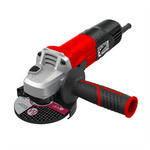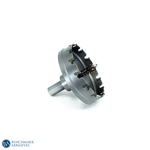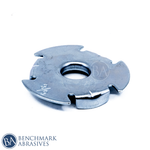
What Safety Precautions Should I Take When Using Wire Brushes

Wire brushes and abrasives are incredibly efficient for cleaning, deburring, grinding, cutting, and finishing. However, you must always adhere to safety regulations and use the guidelines provided by the tool's maker.
Understanding the proper use and maintenance of wire brushes not only enhances productivity but also safeguards users from potential hazards.
You may get the necessary tools and knowledge for properly handling wire brushes by participating in manufacturer training programs. Their focus is exclusively on safe and correct usage. These programs also provide valuable information about potential hazards, helping you work confidently and minimize risks.
SAFETY EDUCATION CAN REDUCE INJURIES
Knowing the safe operational procedures for each tool and product type is crucial. Safety guidelines and best practices can vary depending on the type of instrument (die grinder, right-angle grinder, or bench grinder) and the product type (bonded abrasives, coated abrasives, and power wire brushes).
Human nature dictates that we will go to great lengths to complete a task. It's natural to want to take matters into your own hands and alter the shape or technique. This is to make a product or tool operate as intended. However, if used outside their intended use, these goods may endanger you, your coworkers, and the machinery in your immediate vicinity.
The main objective is to lower personal injury risk. In addition to saving operations money and time, preventing injuries also enhances performance and efficiency, resulting in a positive financial impact. The four fundamental components of speed, size, pressure, orientation, and time (S.P.O.T.) contribute to product safety.
SPEED AND SIZE
Always match the wire brushes or abrasive product's size and speed rating to the tool for safety reasons. Using a product on a tool is not always safe just because it fits.
Maximum R.P.M. ratings are indicated on any tool or product for cutting, grinding, or finishing. For instance, a 412-inch right-angle grinder's standard R.P.M. rating is 11,000, but a 412-inch cutting and grinding wheel's rating is normally 13,000 RPM. Always be sure that the product's R.P.M. rating is more than or equal to that of the tool it is being used on.
Another frequent error is using a brush, disc, or wheel of the incorrect size for the instrument. A 6-inch wheel mounted on a 412-inch grinder is one illustration. Some may believe the larger wheel or disc will offer a deeper cut or longer life, or that it's the only item available. However, when accessories aren't compatible with the tool, they may lose balance and vibrate excessively, leading to failure or loss of control.
Always maintain the guard in place while using the tool as a safe practice. This stops the incorrect accessory from being used on the tool.
PRESSURE
The key to getting the highest performance is to apply proper pressure and let the tool do the work.
When using wire brushes, exerting excessive pressure can stress the wires and limit the product's lifespan by breaking filaments. Applying light pressure and letting the wire tips do the work is better when using wire end brushes.
An audible decrease in RPM indicates that you are applying too much pressure. You may exert too much pressure if you hear the tool's RPM drop or hear and feel the engine struggling.
Performance may also be affected by the speed at which an individual moves over the work surface. When using ceramic grains, this is very accurate. Longer, gentle strokes let the grains do the work, while quick, choppy strokes often create less-than-ideal outcomes.
ORIENTATION
Performance, efficiency, and lifespan of the product can all be significantly impacted by the tool's position and the angle of the workpiece.
Use lower grinding angles (5 to 15 degrees) and lighter pressures, such as when using a Type 27 (flat) profile flap disc. Work at an angle of 15 to 35 degrees when grinding with a Type 29 flap disc for stock removal and aggression. In contrast, a cutting or wire wheel should be applied perpendicular to the part at a 90-degree angle. Even a small change in position can greatly increase the strain on the wire or abrasive, lowering performance and possibly leading to product failure.
Generally speaking, the slower the cutting is, the lower the angle, but the longer the result lasts. On the other hand, the product cuts and wears faster, the steeper the grinding angle. Products come in various profiles, which might be useful for particular purposes like reaching into a confined area or a corner.
TIME
It's essential to track how long you've been using the item and look for any damage or wear that might be a safety risk. Over time, wire brushes deteriorate and lose their diameter. To compensate for the loss of diameter while retaining efficient cleaning or grinding, you must modify your angle of approach, orientation to the workpiece, and the pressure you apply.
Check any product for rust, corrosion, missing flaps, uneven edge wear, cracks, or chips before using it. Never mount a damaged product, and always look for drop damage indicators. Be mindful that there may be unseen cracks or chips if the product has been dropped or you believe it has been dropped.
Time can also relate to how long you stay still in one place while working. It would help if you reduced that time as much as you can. Dwelling increases heat and friction, which causes the product to degrade faster and puts the workpiece at risk of overheating or injury. Make sure to use steady, controlled strokes to keep the product flowing.
DO’S & DON’TS TO FOLLOW WHEN USING A POWER WIRE BRUSH TO AVOID DAMAGE
DO’S:
- Do keep brushes in their original containers and clean and dry. Always be cautious when handling and storing brushes.
- Before using, check wire brushes for rust, corrosion, and degradation.
- Verify the tool's and brush's speed. Do not use brushes unless their speeds are rated at or higher than the tool's rated speed.
- Check your tools for unusual circumstances, such as bent spindles, damaged spindle bearings, or improper spindle size. Maintaining your equipment is essential for safety.
- Make sure to choose your brushes for application carefully. The wrong brush might be hazardous and will not work well.
- Follow the tool installation directions to properly place brushes.
- Wear appropriate personal protection, including an apron, gloves, safety shoes, eye and facial protection, etc.
- If necessary, wear respiratory protection approved by the government.
- Before using this product, please examine the relevant MSDS (Material Safety Data Sheets).
- Before using, run the brush in a covered area for one minute. During the one-minute start-up test, keep your distance from the brush and stay out of its path.
- Check for flutter or vibration in rotating brushes since this could indicate a faulty installation, a broken tool, or a brush.
- Utilize the side handle (angle grinders).
- Use the machine's supplied wheel guard, which has been set correctly.
- When using a brush, use moderate pressure. Excessive pressure results in filament overbending and heat building up, which shortens brush life and causes filament breaking.
- Do point any flying particle stream (shower) away from anyone's face or body. Protect onlookers from flying objects.
- Do not disregard any symbols or cautions printed on the brush or its box.
- Don't forget to follow ANSI B165.1, O.S.H.A., and other safety instructions with brushes.
- Do check the manufacturer's website for further safety information.
- If you have safety concerns, contact your brush maker.
DON’TS:
- If you haven't read through all the safety information and received the necessary training to handle the equipment and brush, don't use a power (wire) brush.
- Never attach brushes to the equipment they do not fit. Don't use the wrong brush or instrument.
- If you and onlookers are not wearing the appropriate personal protection, such as an apron, gloves, safety shoes, etc., do not use a power (wire) brush.
- Never move faster than the power (wire) brush's marked speed.
- Use only clean, undamaged brushes.
- Avoid applying too much pressure when using a brush.
- Utilize only properly guarded machines; do not use other machines.
- Never remove the side handle with the tool (angle grinder).
- To avoid fires, ensure flammable materials are protected from the spark stream (shower) or latent sparks.
- Avoid shoving the project into the brush.
Tips For Choosing the Right Wire Brush
- Material Compatibility: Select a wire brush made from the appropriate material, like stainless steel, brass, or steel, based on the workpiece, to avoid damage.
- Depending on Task Type: Use a stiff, heavy-duty brush for aggressive cleaning, deburring, or rust removal. For delicate finishes, choose a softer or finer wire brush.
- Desired Finish: Coarser brushes are suited for removing tough contaminants and rough shaping. Finer brushes help achieve smooth, polished surfaces.
- Brush Shape: Choose the right brush shape (cup, wheel, end brush) depending on access to different surfaces and specific tasks.
- Application Specifics: Always match the wire gauge and brush type to the material being worked on to ensure safety, efficiency, and optimal results.
Conclusion
Choosing the appropriate wire brush is crucial for finishing and cleaning metal safely and efficiently. Always wear appropriate protective gear, including safety glasses, gloves, and a dust mask, to guard against flying debris and metal particles. By selecting the appropriate wire brush for the desired finish, you can maximize productivity while minimizing the risk of damage or accidents.
Always use high-quality abrasive products for more professional outcomes and an efficient workflow. Remember, safety and proper tool selection are key to successful and injury-free projects.



































































